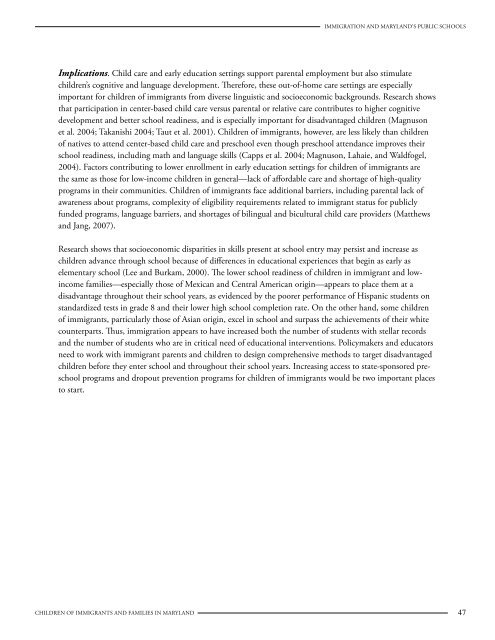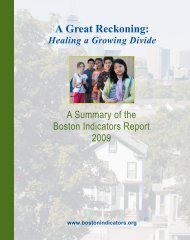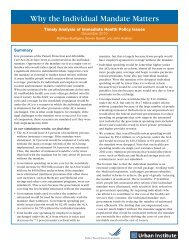The Integration of Immigrants and Their Families in Maryland: A ...
The Integration of Immigrants and Their Families in Maryland: A ...
The Integration of Immigrants and Their Families in Maryland: A ...
Create successful ePaper yourself
Turn your PDF publications into a flip-book with our unique Google optimized e-Paper software.
Immigration <strong>and</strong> Maryl<strong>and</strong>’s Public SchoolsImplications. Child care <strong>and</strong> early education sett<strong>in</strong>gs support parental employment but also stimulatechildren’s cognitive <strong>and</strong> language development. <strong>The</strong>refore, these out-<strong>of</strong>-home care sett<strong>in</strong>gs are especiallyimportant for children <strong>of</strong> immigrants from diverse l<strong>in</strong>guistic <strong>and</strong> socioeconomic backgrounds. Research showsthat participation <strong>in</strong> center-based child care versus parental or relative care contributes to higher cognitivedevelopment <strong>and</strong> better school read<strong>in</strong>ess, <strong>and</strong> is especially important for disadvantaged children (Magnusonet al. 2004; Takanishi 2004; Taut et al. 2001). Children <strong>of</strong> immigrants, however, are less likely than children<strong>of</strong> natives to attend center-based child care <strong>and</strong> preschool even though preschool attendance improves theirschool read<strong>in</strong>ess, <strong>in</strong>clud<strong>in</strong>g math <strong>and</strong> language skills (Capps et al. 2004; Magnuson, Lahaie, <strong>and</strong> Waldfogel,2004). Factors contribut<strong>in</strong>g to lower enrollment <strong>in</strong> early education sett<strong>in</strong>gs for children <strong>of</strong> immigrants arethe same as those for low-<strong>in</strong>come children <strong>in</strong> general—lack <strong>of</strong> affordable care <strong>and</strong> shortage <strong>of</strong> high-qualityprograms <strong>in</strong> their communities. Children <strong>of</strong> immigrants face additional barriers, <strong>in</strong>clud<strong>in</strong>g parental lack <strong>of</strong>awareness about programs, complexity <strong>of</strong> eligibility requirements related to immigrant status for publiclyfunded programs, language barriers, <strong>and</strong> shortages <strong>of</strong> bil<strong>in</strong>gual <strong>and</strong> bicultural child care providers (Matthews<strong>and</strong> Jang, 2007).Research shows that socioeconomic disparities <strong>in</strong> skills present at school entry may persist <strong>and</strong> <strong>in</strong>crease aschildren advance through school because <strong>of</strong> differences <strong>in</strong> educational experiences that beg<strong>in</strong> as early aselementary school (Lee <strong>and</strong> Burkam, 2000). <strong>The</strong> lower school read<strong>in</strong>ess <strong>of</strong> children <strong>in</strong> immigrant <strong>and</strong> low<strong>in</strong>comefamilies—especially those <strong>of</strong> Mexican <strong>and</strong> Central American orig<strong>in</strong>—appears to place them at adisadvantage throughout their school years, as evidenced by the poorer performance <strong>of</strong> Hispanic students onst<strong>and</strong>ardized tests <strong>in</strong> grade 8 <strong>and</strong> their lower high school completion rate. On the other h<strong>and</strong>, some children<strong>of</strong> immigrants, particularly those <strong>of</strong> Asian orig<strong>in</strong>, excel <strong>in</strong> school <strong>and</strong> surpass the achievements <strong>of</strong> their whitecounterparts. Thus, immigration appears to have <strong>in</strong>creased both the number <strong>of</strong> students with stellar records<strong>and</strong> the number <strong>of</strong> students who are <strong>in</strong> critical need <strong>of</strong> educational <strong>in</strong>terventions. Policymakers <strong>and</strong> educatorsneed to work with immigrant parents <strong>and</strong> children to design comprehensive methods to target disadvantagedchildren before they enter school <strong>and</strong> throughout their school years. Increas<strong>in</strong>g access to state-sponsored preschoolprograms <strong>and</strong> dropout prevention programs for children <strong>of</strong> immigrants would be two important placesto start.Children <strong>of</strong> <strong>Immigrants</strong> <strong>and</strong> <strong>Families</strong> <strong>in</strong> Maryl<strong>and</strong> 47
















